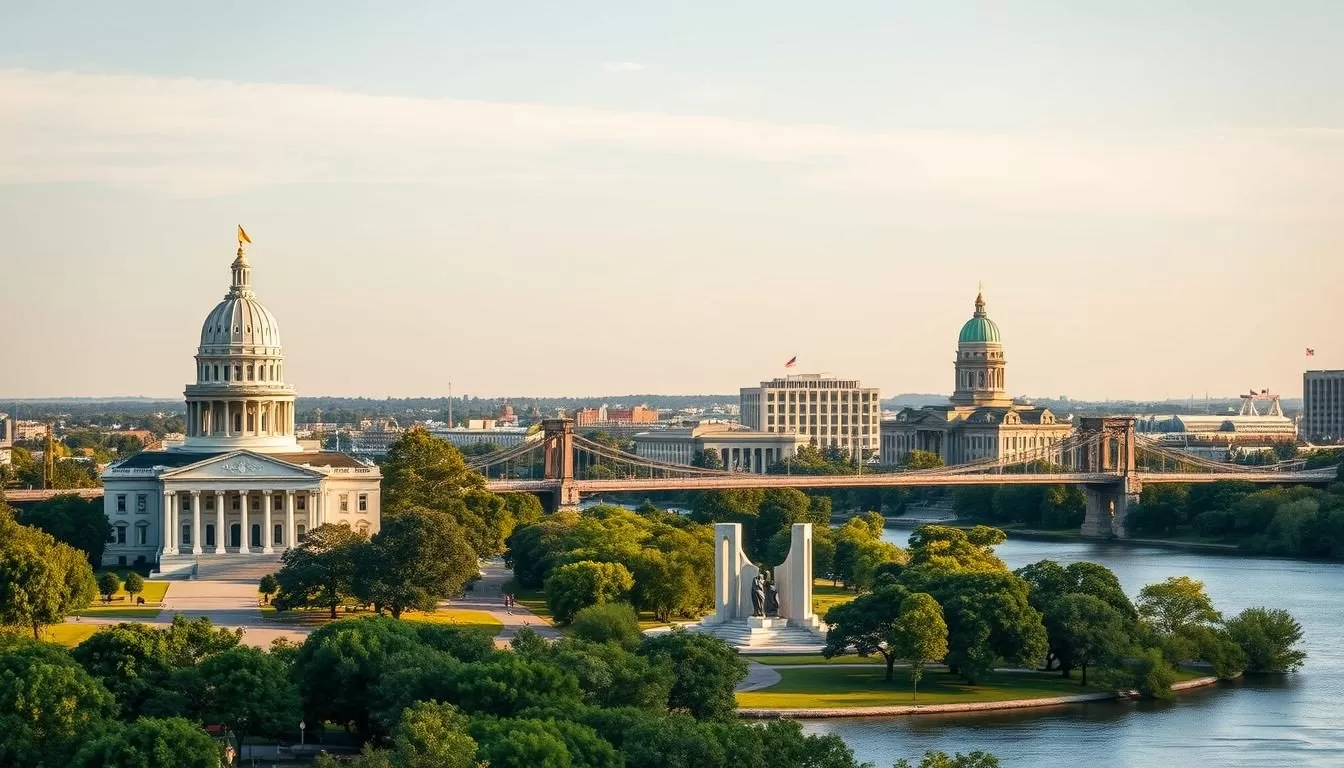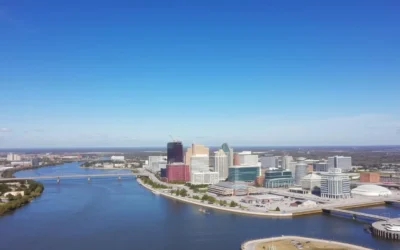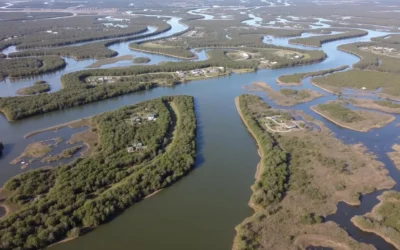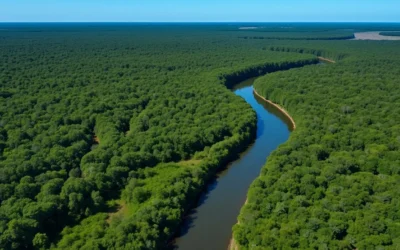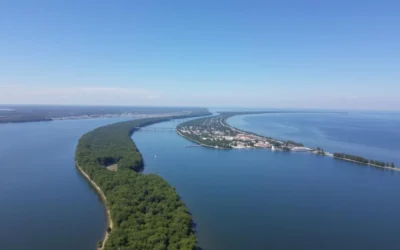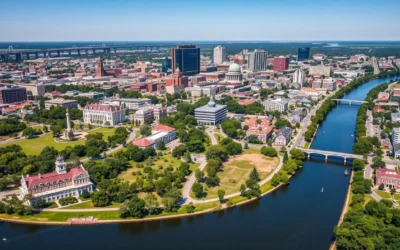Discover the vibrant capital city of Louisiana, where history and culture blend seamlessly. As you plan your visit, you’ll find that Baton Rouge offers a diverse range of activities and attractions.
From historical landmarks to outdoor adventures, there’s something for every type of traveler in this Mississippi River city. You can learn about the rich history behind the city’s name, which means “Red Stick” in French, and explore the unique cultural landscape.
With our guide, you’ll get insider tips on must-visit locations and local favorites that make Baton Rouge a fascinating destination. Plan your perfect itinerary and make the most of your time in this incredible place.
Discovering Baton Rouge: Louisiana’s Capital City
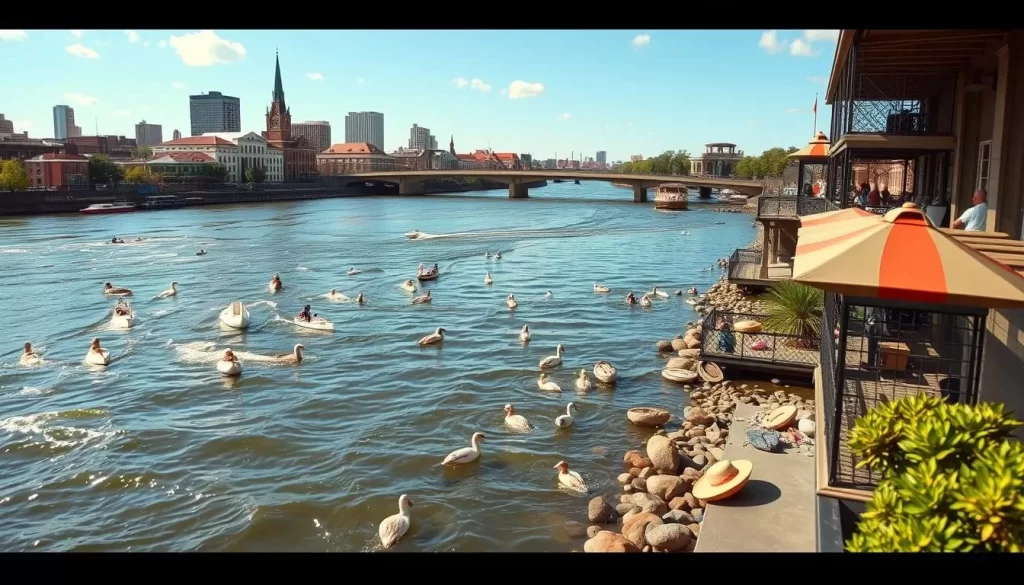
Located along the mighty Mississippi River, Baton Rouge is Louisiana’s capital city, steeped in history and cultural significance. As the capital of Louisiana State, Baton Rouge is a city that offers a rich tapestry of experiences for visitors.
The city’s significance extends beyond its political importance as a capital city. It serves as a cultural hub, blending influences from French, Spanish, African, and American traditions. This unique blend is evident in its architecture, cuisine, and cultural events, making it a fascinating place to explore.
Understanding Baton Rouge’s development from its early days as a French military post to its current status as a vibrant city with a population of over 220,000 residents provides valuable insight into its history. The city’s layout, including its walkable downtown area, makes it easy for visitors to navigate and discover its many attractions within a short distance of each other.
The time to visit Baton Rouge is during the spring (March-April), when temperatures are pleasant, around 71°F, and humidity is lower compared to the hot, humid summers. This makes it an ideal time to enjoy the city’s outdoor and indoor attractions.
Historical Landmarks in Baton Rouge
From Gothic castles to art deco skyscrapers, Baton Rouge’s historical landmarks offer a glimpse into the city’s fascinating history. As you explore these iconic sites, you’ll uncover the stories and significance behind them.
The Old State Capitol Building
The Old State Capitol Building, affectionately known as “The Castle,” is a must-visit attraction in Baton Rouge. Built in 1929, this neo-gothic structure now houses the Museum of Political History, featuring stained glass windows, spiral staircases, and a stained glass dome. Visitors can explore the museum free of charge and enjoy a 12-minute video on the castle’s history.
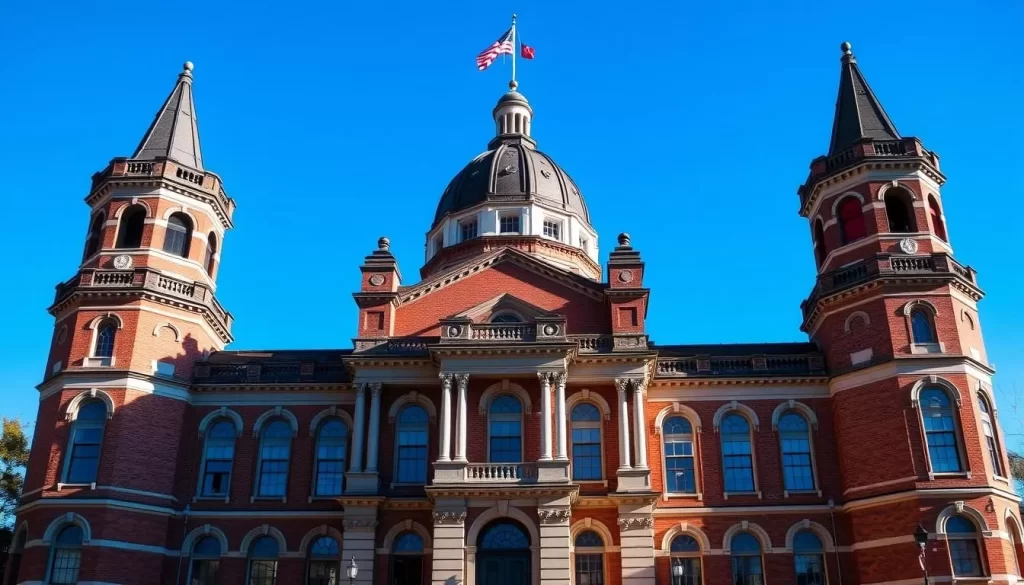
The Current State Capitol Building and 27th Floor Observation Deck
The current State Capitol building, dating back to 1932, is a 34-floor skyscraper that stands as the tallest state capitol in the United States. Visitors can ascend to the 27th floor observation deck for panoramic views of Baton Rouge and the Mississippi River. The building’s art deco style is a notable example of the city’s architectural heritage.
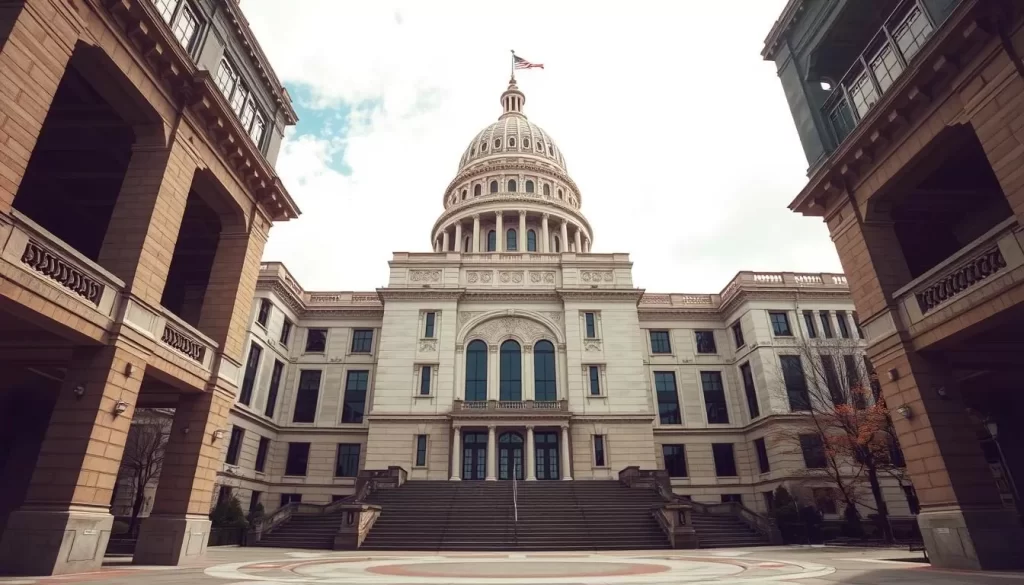
The Old Governor’s Mansion
The Old Governor’s Mansion, once known as “Louisiana’s White House,” was built in 1930. This historic mansion features a grand ballroom, crystal chandeliers, and a marble staircase, along with artifacts from nine former governors. It’s a unique opportunity to step into the past and experience the elegance of a bygone era.
Exploring Baton Rouge’s Military History
As you delve into Baton Rouge’s military past, you’ll uncover a wealth of historical sites and museums. The city’s strategic location has made it a significant player in various military conflicts throughout history.
USS Kidd Veterans Museum
The USS Kidd is a World War II era American Fletcher class Destroyer that earned 12 battle stars during World War II and the Korean War. It was saved from being scrapped and towed to its current location in 1982. You can tour this floating museum, climbing aboard to explore the ship’s decks, quarters, and equipment. Some visitors can even arrange to camp overnight on deck for a truly immersive historical experience.
Baton Rouge Arsenal and Pentagon Barracks
The Baton Rouge Arsenal, built in 1838 as a powder magazine, was once part of the largest military complex in Louisiana. Now, it houses a museum covering the building’s history. You can examine the remarkable brick construction of the Arsenal, designed to keep gunpowder protected in case of attack and bombardment. Additionally, you can learn about the Pentagon Barracks, which have served various military purposes throughout history, reflecting Baton Rouge’s strategic importance during the Civil War and other military conflicts.
Plantation Tours Near Baton Rouge
Discover the rich history of Louisiana’s plantation era by visiting sites near Baton Rouge. The area is home to numerous plantations that offer a glimpse into the region’s complex past, from the early days of colonization to the grandeur of the antebellum era.
Magnolia Mound Plantation
Magnolia Mound Plantation, built in 1786, is one of the oldest buildings in Baton Rouge. Unlike the grander plantation homes that came later, Magnolia Mound feels more like a working home, providing insight into the daily lives of the people who lived and worked there. You can explore the plantation house and its grounds to gain a deeper understanding of early Louisiana plantation life.
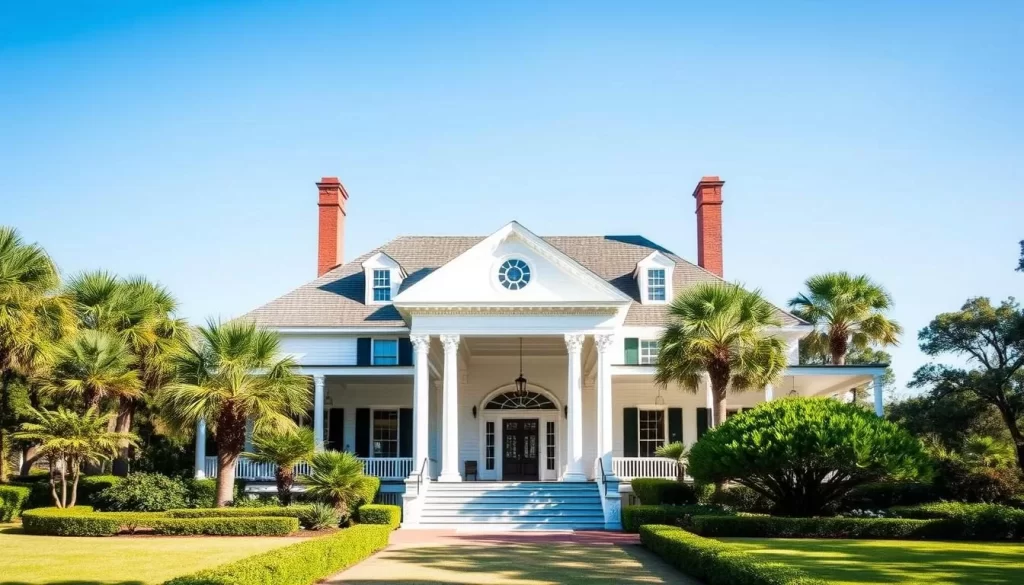
Nottoway Plantation
Nottoway Plantation, located near Baton Rouge, is the largest antebellum mansion in the South. Built in the Greek Revival style in 1859, it exemplifies the wealth and grandeur of the later plantation culture. Visitors can explore Nottoway’s impressive White Ballroom, enjoy views over the Mississippi River, and learn from period-dressed guides who bring the history to life. You can even stay overnight at Nottoway Plantation, as it operates as a hotel, offering a unique opportunity to experience life in a historic plantation house.
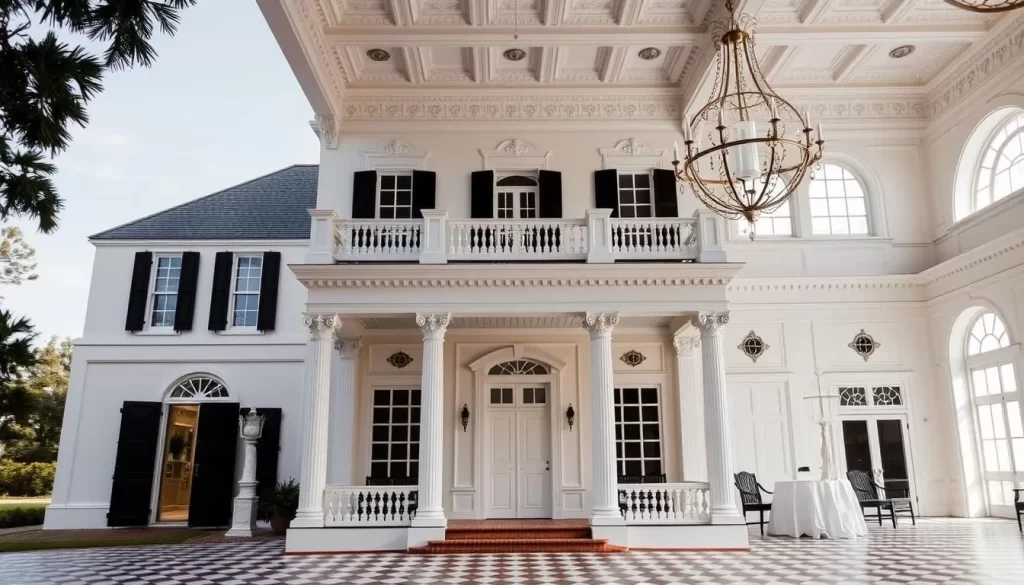
Visiting these plantations near Baton Rouge allows you to compare the modest but historically significant Magnolia Mound with the opulent Nottoway Plantation. This contrast highlights the evolution of plantation culture in Louisiana over time, from the simpler homes of the early plantation era to the grand mansions that symbolized wealth and status in the antebellum South.
Museums and Cultural Attractions
As you explore Baton Rouge, you’ll find a variety of museums and cultural attractions that highlight the city’s heritage and cultural significance. The city’s museums offer a range of experiences, from historical exhibits to art galleries and interactive science displays.
Capitol Park Museum
The Capitol Park Museum is a comprehensive museum that covers the history of Louisiana, from Native Americans and early settlers to famous figures like Louis Armstrong and Huey Long. The museum’s diverse exhibits include slavery, civil rights, local industries like shrimping and sugar cane harvesting, and cultural phenomena like Mardi Gras. You can spend half a day or more examining the museum’s diverse exhibits.
LSU Rural Life Museum
The LSU Rural Life Museum is dedicated to the culture of 18th and 19th century rural Louisianans, with over 30 historic buildings to explore. You can experience the peaceful grounds of the Rural Life Museum as you wander among authentic structures that help illustrate what life was like for folks who lived off the land in this part of the world.
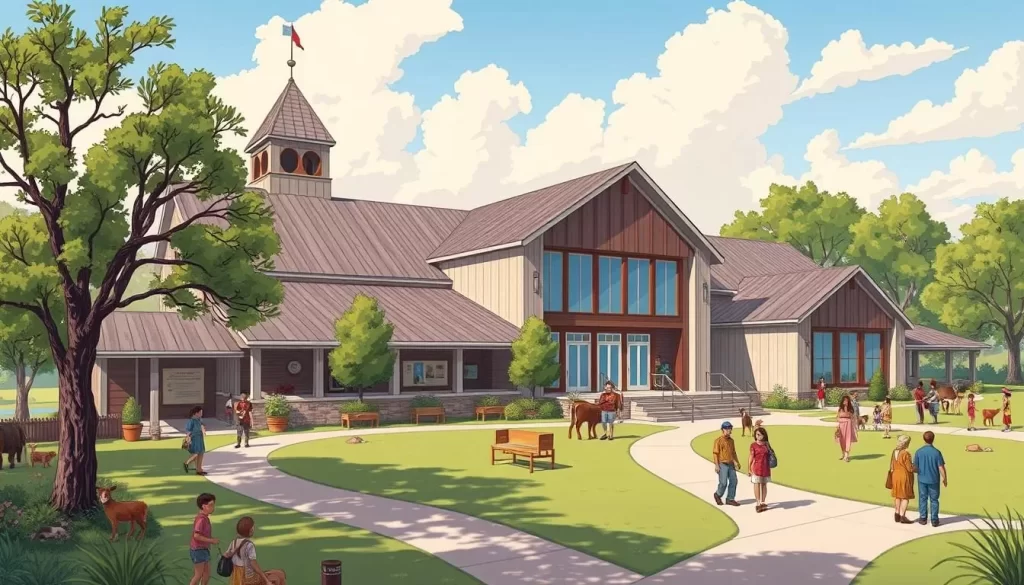
Louisiana Art and Science Museum
The Louisiana Art and Science Museum offers a unique blend of art, science, and education. The museum features diverse art collections, interactive science galleries, and planetarium shows. Notably, the museum offers free admission on the first Sunday of each month.
In summary, Baton Rouge’s museums and cultural attractions provide a rich cultural experience, with something for everyone. Whether you’re interested in history, art, or science, you’ll find a museum or attraction that suits your interests.
Outdoor Activities in Baton Rouge
Baton Rouge offers a range of outdoor activities that allow you to connect with nature. The city has several natural attractions that are worth visiting.
BREC’s Blue Bonnet Swamp Nature Center
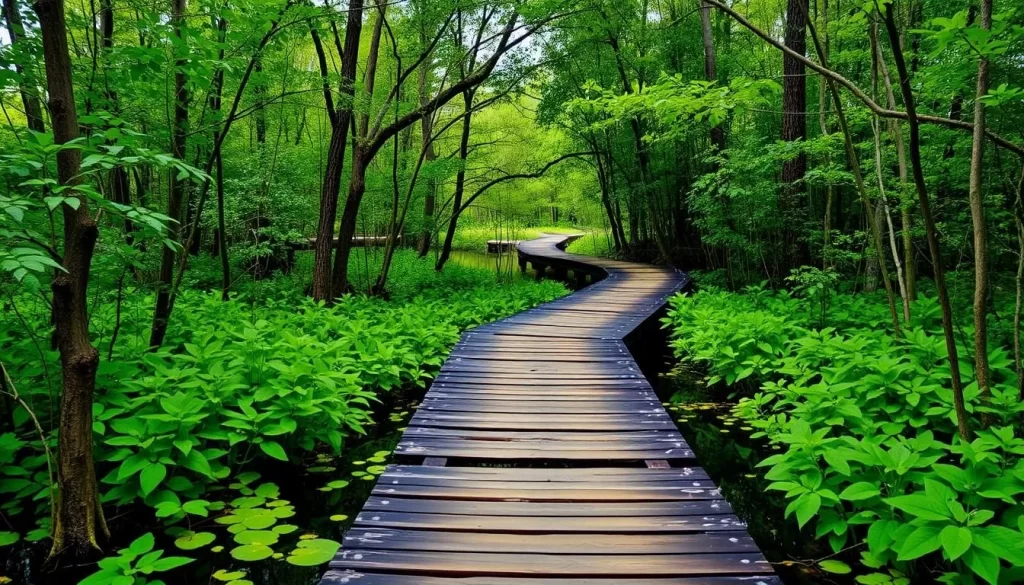
BREC’s Blue Bonnet Swamp Nature Center is a 103-acre recreational swamp located in South Baton Rouge. You can explore the walking trails through woodlands and swamp areas, spotting local wildlife such as birds, turtles, and the occasional alligator. The nature center provides a unique opportunity to experience Louisiana’s famous wetland ecosystems without leaving the city.
Mississippi Riverfront and Sunset Views
The Mississippi Riverfront is a favorite spot for photographers and visitors, offering beautiful sunset views. You can take a walk along the riverfront paths, enjoying the scenic views of passing river traffic and the impressive bridge spanning the Mississippi. It’s a great place to pack a picnic and watch the sun set behind the western bank of the Mississippi.
Outdoor activities in Baton Rouge provide a great way to spend your time in the area. You can enjoy the natural beauty of the city and its surroundings, making the most of your visit.
Family-Friendly Attractions
When it comes to family-friendly attractions, Baton Rouge has a lot to offer, from interactive museums to stargazing opportunities. Families visiting the city can enjoy a variety of activities that cater to children of all ages, ensuring a fun and memorable experience for everyone.
Knock Knock Children’s Museum
The Knock Knock Children’s Museum is a hands-on, interactive space designed for children aged 0-8 years, featuring 18 different zones that encourage learning through play. This award-winning museum is an ideal destination for families, providing a colorful and engaging environment that stimulates creativity and curiosity in young minds.
At the Knock Knock Children’s Museum, children can explore various interactive exhibits, engaging in activities that promote learning and development. The museum’s focus on play-based learning makes it an excellent choice for families seeking educational yet entertaining experiences.
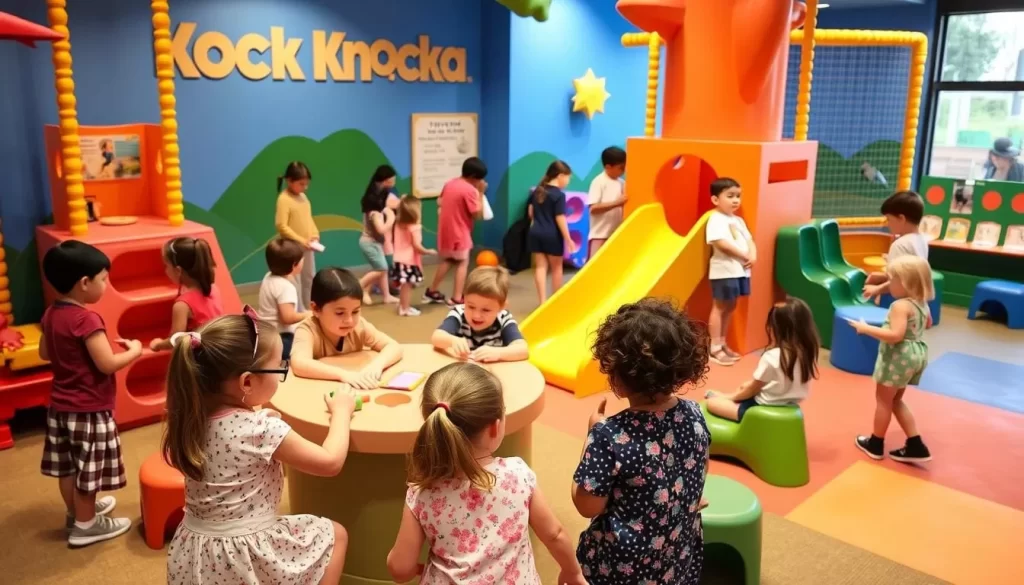
Highland Road Park Observatory
The Highland Road Park Observatory offers a unique opportunity for families to explore the night sky together. With its professional-grade reflecting telescopes, visitors can gaze at the stars, planets, and other celestial objects, gaining a deeper appreciation for the wonders of the universe.
The observatory hosts free events such as solar viewing during the day and evening sky watching sessions, where expert guides help identify constellations and planets. Families can plan their visit around special events like meteor showers or eclipses, making for a memorable and educational experience.
Arts and Entertainment in Baton Rouge
The arts and entertainment scene in Baton Rouge is a vibrant reflection of the city’s rich cultural heritage. As you explore the city, you’ll discover a variety of venues that showcase local and regional artists, performers, and musicians.
Shaw Center for the Arts
The Shaw Center for the Arts is a multifaceted cultural hub located in Downtown Baton Rouge. This center houses a mix of creative venues, including an art gallery, theatre, and a rooftop sushi restaurant with stunning city views. You can catch a show at the Manship Theatre within the Shaw Center, which hosts a diverse range of performances throughout the year, from classical concerts and musicals to drama and comedy.
Baton Rouge’s Arts District
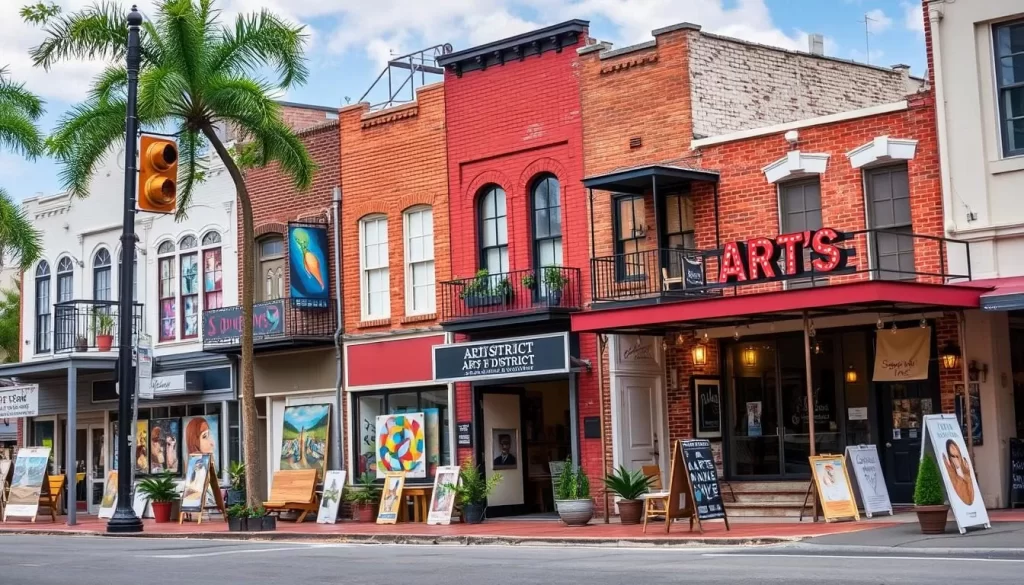
Baton Rouge’s Arts District is a thriving area around Government Street, where you’ll find numerous galleries and creative spaces showcasing local and regional artists. Spend an afternoon exploring the district, visiting specific galleries like Ann Connelly Fine Art, Baton Rouge Gallery, The Contemporary Art Gallery, and The Foyer to experience the vibrant local art scene. Be sure to check the calendar for special arts events and gallery openings that might coincide with your visit, offering opportunities to meet local artists and enjoy the creative community of Baton Rouge.
Baton Rouge, Louisiana: Best Things to Do – Top Picks for Food Lovers
For those who love food, Baton Rouge is a paradise, with its unique blend of Cajun and Creole cuisine that is sure to tantalize the taste buds. The city’s culinary scene is a reflection of its rich cultural heritage.
Cajun and Creole Cuisine
Baton Rouge is renowned for its Cajun and Creole cuisine, a culinary style that is both flavorful and rich in history. To experience the best of this cuisine, visit Jubans, which offers a creative mash-up of Cajun and Creole flavors.
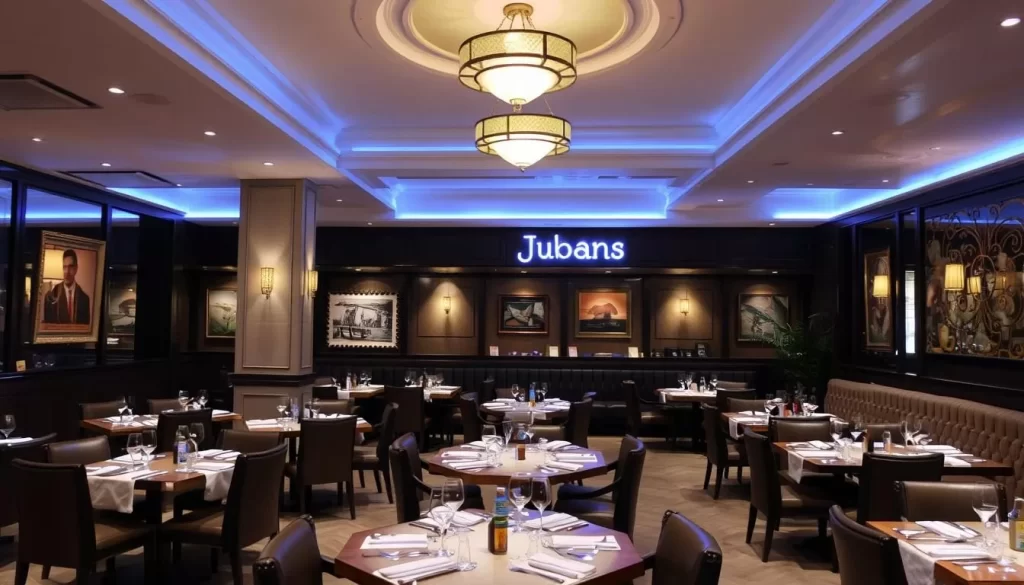
For a more stylish take on Creole food, head to Eliza Restaurant, known for its contemporary approach to traditional Creole dishes. Alternatively, Cecilia Creole Bistro provides a swanky dining experience with an authentic Creole menu.
For a more casual dining experience, Rice & Roux is a local favorite that serves delicious Louisiana fare at reasonable prices.
Local Food Specialties to Try
When in Baton Rouge, be sure to try some of the local specialties. One dessert you shouldn’t miss is the Louisiana Russian Cake (Creole Trifle), a traditional dessert dating back to 1872.
The city’s cuisine is also known for its bold flavors and dishes like gumbo, jambalaya, crawfish étouffée, and beignets, all of which can be found at various restaurants throughout Baton Rouge.
- Sample authentic Cajun and Creole cuisine at renowned Baton Rouge restaurants.
- Visit Eliza Restaurant or Cecilia Creole Bistro for a stylish Creole dining experience.
- Try local favorite Rice & Roux for accessible Louisiana fare.
- Don’t miss the opportunity to taste Louisiana Russian Cake, a unique dessert with a rich history.
- Explore the distinctive flavors of Louisiana cuisine, from gumbo to beignets.
Nightlife and Entertainment
When the sun sets in Baton Rouge, the city’s vibrant nightlife comes alive with a variety of entertainment options. You can experience the best of Baton Rouge’s entertainment scene, which caters to different tastes and preferences.
Live Music Venues and Teddy’s Juke Joint
For live music enthusiasts, Baton Rouge has a number of venues that host various genres. One standout is Teddy’s Juke Joint, a quintessential blues venue that’s been operating for over 40 years in the very house where owner Teddy Johnson was born.
Experience authentic Louisiana blues at Teddy’s Juke Joint, where you can enjoy live music 365 days a year, accompanied by their famous red beans and rice.
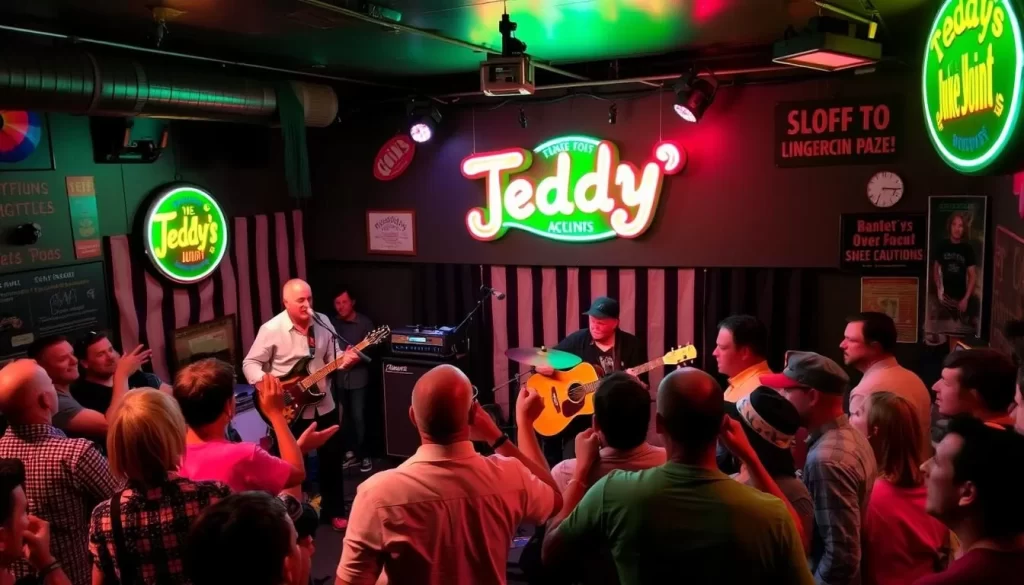
Bars and Breweries
Baton Rouge’s bar scene is diverse, with options ranging from trendy spots like Radio Bar, set in an old industrial building, to the more upscale MidCity Beer Garden and the cozy Hayride Scandal.
You can also visit Tin Roof Brewery, which offers free tours and tastings of their craft beers made with the finest American and European malts.
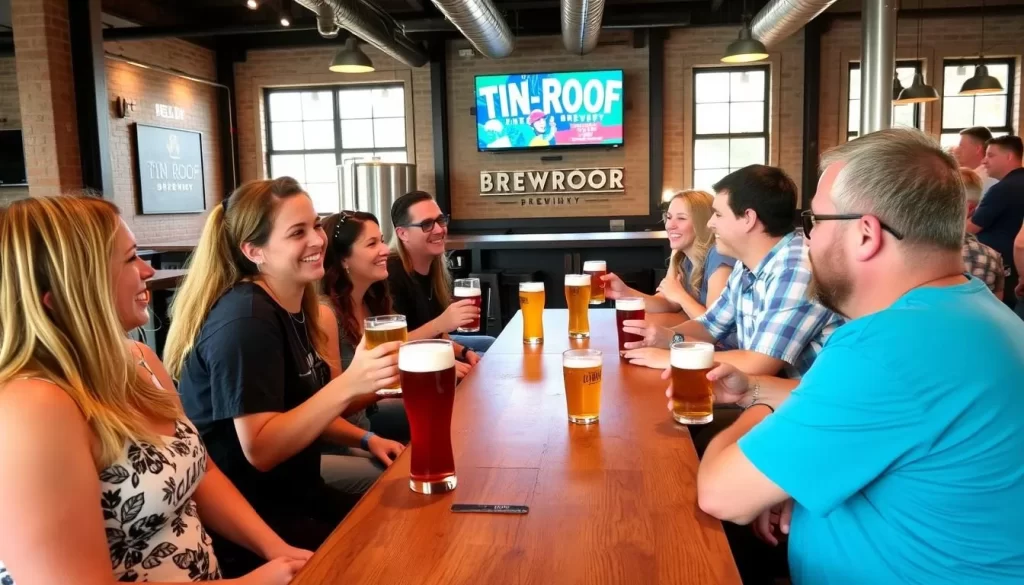
In addition to these venues, don’t miss Live After Five, a series of free concerts held on Friday evenings during spring and fall in downtown Baton Rouge. It’s a great way to celebrate the weekend with music and dancing.
Free Things to Do in Baton Rouge
Discover the charm of Baton Rouge through its array of free attractions and activities. The city offers a range of experiences that cater to different interests, ensuring that there’s something for everyone.
Free Museums and Attractions
Baton Rouge is home to several museums that offer free admission on certain days. Many museums participate in “Free First Sunday,” including the Louisiana State University Museum of Art, Louisiana Art and Science Museum, and the USS Kidd Veterans Museum. You can also visit the State Capitol building and its 27th floor observation deck at no cost, enjoying panoramic views of the city and the Mississippi River.
Other free attractions include the Old Arsenal Museum, where you can learn about the military history of the region, and Saint Joseph Cathedral, a historic monument dating back to 1853. These attractions provide a glimpse into the city’s rich history and cultural heritage.
| Museum/Attraction | Free Admission | Notable Features |
|---|---|---|
| Louisiana State University Museum of Art | First Sunday of the month | Varied art collections |
| State Capitol building | Any day | 27th floor observation deck |
| Old Arsenal Museum | Any day | Military history exhibits |
Parks and Public Spaces
Baton Rouge also boasts numerous parks and public spaces that are free to visit. You can take a stroll through Spanish Town, the oldest neighborhood in Baton Rouge, and admire the historic homes. Other parks like North Sherwood Forest Community Park and the LSU Hilltop Arboretum offer a serene escape from the city’s hustle and bustle.

These green spaces provide a perfect setting for a picnic, a walk, or simply enjoying the outdoors. With their natural beauty and recreational facilities, they are an integral part of Baton Rouge’s charm.
Seasonal Events and Festivals
Experience the vibrant culture of Baton Rouge through its numerous seasonal events and festivals, each with its unique charm. The city’s event calendar is filled with exciting activities that cater to different interests and ages.
Mardi Gras in Baton Rouge
Mardi Gras in Baton Rouge offers a more family-friendly and relaxed atmosphere compared to the famous New Orleans celebrations. You can attend various Mardi Gras parades, including unique options like one dedicated entirely to dogs, or the famous Spanish Town parade known for its more risqué content.
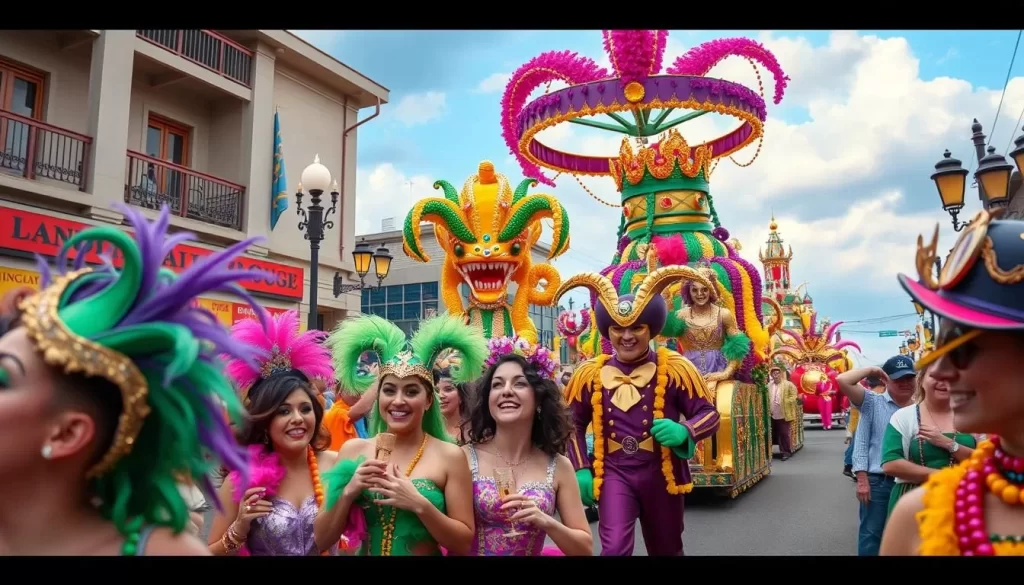
Other Annual Festivals
Baton Rouge hosts a range of other annual festivals that are worth attending. You can plan your visit around events like the “Wearin’ of the Green” St. Patrick’s Day parade, one of the oldest Blues festivals in the country, or the popular Red Stick Food Fest benefiting the Louisiana Hospital Foundation.
You can also enjoy seasonal celebrations like the Festival of Lights, which kicks off the Christmas season with decorations, train rides, a snow village, and a tree lighting ceremony culminating in fireworks. Additionally, sample local cuisine at food-focused events like the Fried Chicken Festival, a free outdoor festival featuring delicious food, music, eating contests, and other festivities that showcase Louisiana’s culinary traditions.
Day Trips from Baton Rouge
You can easily take a day trip from Baton Rouge to experience the best of Louisiana. The city is surrounded by a rich natural landscape and a wealth of cultural attractions.
Avery Island and Tabasco Factory
One of the most popular day trips from Baton Rouge is to Avery Island, home of the world-famous Tabasco Sauce since 1868. On this day trip, you can tour the Tabasco Factory and learn about the production process of this iconic hot sauce.

Explore beyond the Tabasco Factory to discover Avery Island’s natural beauty, including coastal marshes, subtropical flora and fauna, and the stunning Jungle Gardens with Spanish moss draping from ancient trees. Visit the surprising Buddhist temple on Avery Island and learn about the fascinating geology of the area.
Tunica Hills
For nature lovers, a day trip to Tunica Hills is a must. Just an hour’s drive north of Baton Rouge, Tunica Hills offers three hiking trails through 6,000 acres of rolling hills and wooded areas. You can spend the day hiking and watching for wildlife, including wild turkeys, white-tailed deer, rabbits, squirrels, chipmunks, and migratory birds.
With its diverse wildlife and natural beauty, Tunica Hills is a great place to spend a day outdoors. You can seek out the hidden waterfall that rewards persistent explorers or simply enjoy the scenery.
Getting Around Baton Rouge
As you plan your trip to Baton Rouge, consider how you will travel between the city’s many attractions. Baton Rouge is a city that offers a variety of experiences, from historical landmarks to cultural events, and understanding your transportation options is key to enjoying your visit.
Transportation Options
Baton Rouge offers several transportation options to suit different needs. For out-of-town attractions like plantations, Avery Island, or Tunica Hills, renting a car is a practical choice. Many attractions are within a short drive of each other, making a car an ideal way to explore the area.
For those who prefer not to drive, there are other options to consider, although they may be more limited. The city’s walkability, especially in the downtown area, makes walking a viable option for shorter distances.
Navigating the City
Navigating Baton Rouge is relatively straightforward, thanks to its layout. The downtown area is particularly walkable, with major attractions like the State Capitol, Old State Capitol, museums, and riverfront within a five to ten-minute walk of each other. You can plan your days efficiently by grouping attractions by area, dedicating one day to exploring downtown sites, another to visiting plantations, and perhaps a third to taking a longer excursion.
When renting a car, be sure to look into parking options, as some hotels charge for parking, although rates are generally reasonable compared to larger cities.
Conclusion
Your exploration of Baton Rouge reveals a city that seamlessly weaves together historical significance, cultural vibrancy, and natural beauty. As you reflect on the diverse array of attractions, it’s clear that Baton Rouge offers something for everyone, from its rich historical sites and museums to its vibrant food scene and natural areas.
One of the standout aspects of visiting Baton Rouge is the opportunity to experience authentic Louisiana culture without the crowds often found in its more famous neighbor, New Orleans. The city’s walkable downtown area makes exploring its main attractions convenient and enjoyable for visitors of all ages.
Family-friendly activities abound in Baton Rouge, with numerous educational and entertaining options for children alongside cultural and culinary experiences tailored for adults. As you plan your return visit, consider experiencing the city’s seasonal events like Mardi Gras or exploring the surrounding areas, including the historic plantation homes along River Road and the natural beauty of Louisiana’s swamps and forests.
In conclusion, Baton Rouge serves as both a compelling destination in its own right and an excellent base for exploring the wider cultural and natural attractions of southern Louisiana. With its unique blend of history, culture, and natural beauty, Baton Rouge is a city that will leave you wanting to return and explore more of what it has to offer.
The above is subject to change.
Check back often to TRAVEL.COM for the latest travel tips and deals.
